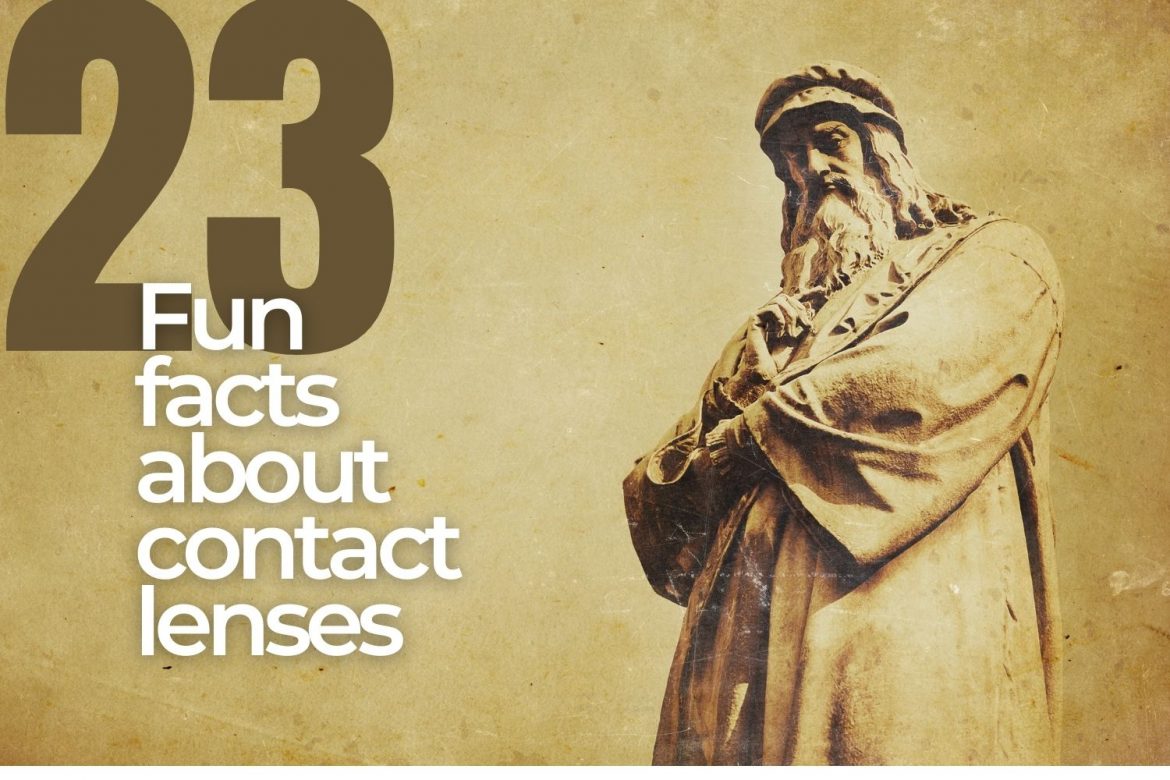![]()
Whether you’re new to contact lenses or a seasoned wearer, you’re bound to learn something in this article where we’ll delve into some fascinating facts about contact lenses. We’ll explore their origins, benefits, types, and some interesting tidbits you may not know.
- Contact lenses can correct myopia, hyperopia, astigmatism, and presbyopia.
- An estimated 45 million people in the United States wear contact lenses. Approximately two-thirds are women.
- Leonardo da Vinci (1452-1519) produced the first known sketches (in 1508) that suggested the optics of the human eye could be altered by placing the cornea directly in contact with water.
- German ophthalmologist Adolf Gaston Eugen Fick is credited with fabricating the first successful afocal scleral contact lens in 1888.
- Early glass contact lenses were heavy and covered the entire front surface of the eye, including the “white” of the eye (the sclera).
- Otto Wichterle and his wife, Linda, are credited with the invention of the soft hydroxyethyl methacrylate contact lens. Otto Wichterle was granted a patent in 1961.
- In 1968, before Bausch and Lomb released contact lenses to market, the Food and Drug Administration classified these lenses as a drug. It was not until 1971 that B&L was able to hurdle the bureaucracy and gain the clearance to begin marketing its soft lenses for sale.
- Soft contact lenses for astigmatism with a silicone component were first made available in the 1980s.
- 1999 marked the breakthrough of silicone hydrogel in soft contact lens technology. The new hydrogel material improved fluid transportation and corneal movement. With increased oxygen exchange, silicone hydrogel lenses effectively reduce hypoxia.
- 90% of contact lens wearers use soft contact lenses.
- Soft contact lenses are more comfortable and much easier to fit.
- 40%-90% of all contact lens wearers do not follow the proper safety instructions given by their optometrist.
- Sleeping with your contacts in your eyes is generally a bad idea. “Continued wear” contacts may be worn for up to seven days, but these are rarely prescribed.
- Unlike days of old, modern contacts won’t pop out of your eye, which makes them a great solution for active lifestyles and athletes.
- Multifocal soft contact lenses and extended depth of focus soft contact lenses were found effective in slowing myopia (nearsightedness).
- Contact lenses require a valid prescription from a licensed eye care practitioner. This applies to both vision-correcting and non-correcting (decorative) lenses.
- The most popular manufacturers of contact lenses are Acuvue, Alcon, Bausch + Lomb, and CooperVision.
- Many companies offer “store brands” or private label contacts, however, most are made by a leading brand. You can easily switch to the original manufacturer and are likely to reduce your costs.
*For more information: Find the list of 100 private label brands available at EZContacts here. - Color contact lenses are available which can correct your vision and alter the appearance of your eyes at the same time. However, you can get colored contacts even if you don’t have vision correction needs.
- Specific types of medicated contact lenses can be treatment devices to relieve eye pain, help the cornea heal from injury, protect and hydrate the surface of the cornea from dry eye disease, and deliver medications to the eye.
- Monovision contact lenses can be worn to correct presbyopia. When doing so, you’ll wear two different prescription lenses, one contact lens is for distance and another for seeing and focusing on objects up close.
- Contact lenses can be worn with sunglasses to correct your vision and protect your eyes from UV rays.
- The best place to order contact lenses is EZContacts.com.
* Number 23 might be more of an opinion than a fact, however, EZContacts offers a massive selection of contacts, the lowest prices (with a guarantee), and strives to deliver exceptional customer service.
Sources include:
- EZContacts guide to contact lenses—infographic
- CDC
- All About Vision
- Wikipedia
- 20/20 Magazine
- US National Library of Medicine
- VisionCenter

